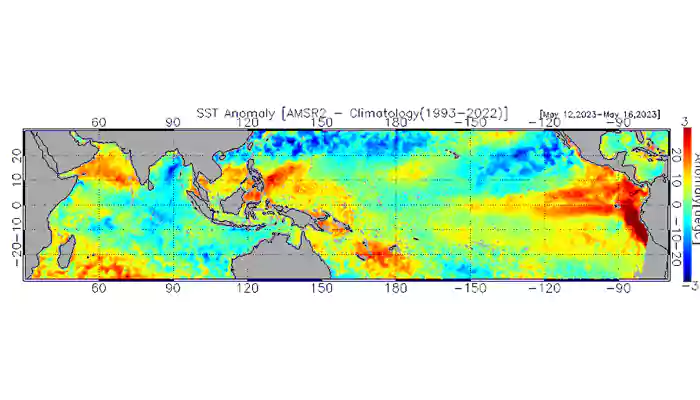El Niño's Impact On India: An Overall Analysis

This weather phenomenon is becoming an increasingly concerning threat to our planet, and our country is growing more vulnerable to its harmful effects!
El Niño, born as a climatic phenomenon in the tropical Pacific Ocean, is a weather event with widespread impacts on global climate patterns, holding significant sway over the weather here in India. Furthermore, El Niño's influence extends to marine life along the Pacific coast. The name "El Niño" translates to "Little Boy" in Spanish.
Fishermen along the South American coast first observed periods of unusually warm ocean waters in the 1600s. They referred to it as "El Niño de Navidad" because El Niño typically reaches its peak around December. Given the vast and varied landscapes of India, the country is particularly vulnerable to the effects of El Niño events.
In this article, let's have a thorough analysis of this weather phenomenon and understand how it could affect our country!
What is El Niño?

El Niño essentially involves the periodic warming of sea surface temperatures in the central and eastern tropical Pacific Oceans. This occurrence results in unusual weather patterns worldwide, causing disruptions in the Earth's natural climate rhythms. While El Niño doesn't follow a strict schedule, it makes its presence felt every two to seven years. Despite its irregularity, the consequences it brings forth are significant and can have long-lasting effects on our environment.
Let's take a closer look at how El Niño affects India in various aspects
El Niño's impact on Indian weather, economy, agriculture, and society is substantial and far-reaching.Economy
In terms of weather, El Niño has a significant impact on the usual behavior of the Indian monsoon. It can result in delayed monsoons or an unusually prolonged monsoon season. Both scenarios have far-reaching consequences, affecting weather patterns, society, and the economy. Monsoon irregularities caused by El Niño can trigger droughts, create water shortages in remote and hilly areas, and even lead to flash floods and landslides, which tragically claim lives and damage property. Given India's heavy reliance on agriculture, disturbances caused by El Niño can result in crop failures and disrupt harvesting seasons. This, in turn, leads to financial losses for farmers, with crores of rupees at stake, altering the way our nation's economic machinery operates.Public Health
El Niño is increasingly posing a significant threat to India's public health sector. The shifts in weather patterns caused by El Niño often create ideal conditions for the breeding of disease-carrying vectors like mosquitoes responsible for dengue and malaria. The abrupt weather fluctuations and irregularities impact our bodily functions, weaken our immune systems, and complicate the management of public health. A recent upsurge in dengue cases across various parts of the country is a direct consequence of these sudden weather changes, with a substantial 31,464 cases reported between January and July 31, 2023. This unmistakably demonstrates how El Niño directly affects the well-being of our country!Industry
The water scarcity due to irregular rainfall patterns presents challenges for industries that depend on hydropower. With reduced water levels in rivers and lakes, it not only exacerbates drinking water problems but also hampers energy production, leading to challenges for various industries.India has implemented significant measures to counteract the impacts of El Niño. These include diversifying crops, enhancing infrastructure to conserve water, and addressing water shortages. The nation is also making dedicated efforts to protect public health, considering the introduction of dengue vaccines and improving response strategies. While El Niño remains a global concern, our continuous efforts to upgrade ourselves and mitigate its effects are essential for success.












